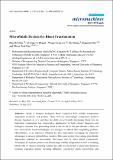Microfluidic Devices for Blood Fractionation
Author(s)
Hou, Han Wei; Bhagat, Ali Asgar S.; Lee, Wong Cheng J.; Huang, Sha; Han, Jongyoon; Lim, Chwee Teck; ... Show more Show less
DownloadWei-2011-Microfluidic Devices.pdf (3.219Mb)
PUBLISHER_CC
Publisher with Creative Commons License
Creative Commons Attribution
Terms of use
Metadata
Show full item recordAbstract
Blood, a complex biological fluid, comprises 45% cellular components suspended in protein rich plasma. These different hematologic components perform distinct functions in vivo and thus the ability to efficiently fractionate blood into its individual components has innumerable applications in both clinical diagnosis and biological research. Yet, processing blood is not trivial. In the past decade, a flurry of new microfluidic based technologies has emerged to address this compelling problem. Microfluidics is an attractive solution for this application leveraging its numerous advantages to process clinical blood samples. This paper reviews the various microfluidic approaches realized to successfully fractionate one or more blood components. Techniques to separate plasma from hematologic cellular components as well as isolating blood cells of interest including certain rare cells are discussed. Comparisons based on common separation metrics including efficiency (sensitivity), purity (selectivity), and throughput will be presented. Finally, we will provide insights into the challenges associated with blood-based separation systems towards realizing true point-of-care (POC) devices and provide future perspectives.
Date issued
2011-07Department
Massachusetts Institute of Technology. Department of Biological Engineering; Massachusetts Institute of Technology. Department of Electrical Engineering and Computer ScienceJournal
Micromachines
Publisher
MDPI AG
Citation
Hou, Han Wei, Ali Asgar S. Bhagat, Wong Cheng Lee, Sha Huang, Jongyoon Han, and Chwee Teck Lim. “Microfluidic Devices for Blood Fractionation.” Micromachines 2, no. 4 (July 20, 2011): 319–343.
Version: Final published version
ISSN
2072-666X